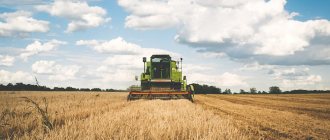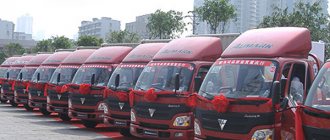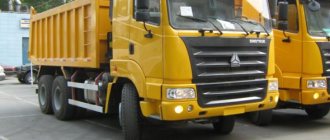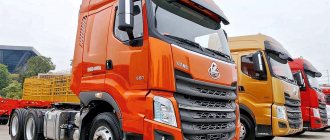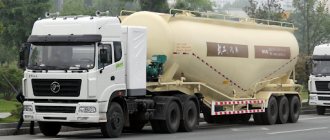Tractor and its categorization
All transport that operates on the territory of the Russian Federation is conditionally divided into several categories. The classification is based on the following characteristics - technical and running parameters. In 2022, machines are divided into seven categories, including A1 and A2, B, C, D, E and F. As for tractors, they can be classified into most of these “sections”. Here a lot depends on the characteristics of the vehicle. Let's highlight the main options:
- “B” - this includes vehicles on wheels or tracks, if the motor power is not more than 25.7 kW.
- "WITH". This category includes wheeled equipment with a power from 25.7 to 110.3 kW. As an example. MTZ-80.
- "D". This includes all vehicles with an engine having a power of 110.3 kW or more. A prerequisite is that the vehicle has wheels (example - K-744 R).
- "E". In this category, all equipment is on tracks and with a motor power of 25.7 kW or more (example - DT-75).
- "F". This is another category that includes all agricultural transport.
Taking into account the above, it is clear that the main criterion by which the division into categories occurs is motor power.
Who is exempt from paying tractor tax?
Many farmers, entrepreneurs and individuals are mistaken if they believe that any agricultural equipment, including tractors, is not subject to transport tax. Upon careful reading of paragraph 2 of Art. 358 of the Tax Code of the Russian Federation, one can understand the main condition for the exemption of such a vehicle (vehicle) from taxation . It says:
2. The following are not subject to taxation:
5) tractors, self-propelled combines of all brands, special vehicles (milk tankers, livestock carriers, special machines for transporting and applying mineral fertilizers, veterinary care, maintenance), registered to agricultural producers and used in agricultural work for the production of agricultural products.
Thus, the legislation actually spells out a list of taxable objects, as well as those types of transport that are not included in their number. This also includes tractors and other machines for agriculture, but only if they are owned by persons involved in the production of agricultural products, in accordance with paragraphs 5 p. 2 art. 358 NK . These may include both legal entities - enterprises and organizations, and individuals - such as peasant farms.
When can you not pay tax?
The law of the Russian Federation provides for cases in which the owner of a tractor can evade the need to pay transport tax. This is possible for vehicles that meet the following conditions:
- Motor power is less than 5 “horses”.
- The number of horsepower does not exceed 100 units, and the owner of the vehicle is disabled. In this case, the vehicle must be obtained with the help of a social service.
- The tractor is used for harvesting agricultural products. To confirm this fact, it is necessary to draw up special papers and transfer the package to the Federal Tax Service.
- The tractor is stolen and there is confirmation of this. In particular, the owner of the vehicle must contact the police and file a statement, receiving a special certificate.
- The equipment is on the balance sheet of the Ministry of Emergency Situations.
Transport tax rate by region of the Russian Federation
When calculating transport tax, many aspects are taken into account. First of all, the power of the motor is taken into account. In second place is the coefficient, which is individual for each region of Russia. At the same time, residents of the capital or St. Petersburg will have to pay more than citizens living in the outback.
The Tax Code of the Russian Federation (Article 358) states that a tractor is a vehicle that belongs to a tracked or pneumatic mechanism. This means that when calculating the tax, the number of horsepower is taken into account.
When determining rates, you need to look at the information that is relevant at the time of calculation. For example, in 2022, residents of Vladimir and Voronezh calculate the transport tax taking into account the following rates - 20, 28 and 40. They are typical for tractors with power up to 100 hp, from 100 to 150 hp, and also from 150 to 200 hp respectively. Cheaper tariffs are in Kaluga, where the rates are equal - 5, 20 and 40 (for the ranges indicated above). If the transport has more power, the cost of paying transport tax also increases.
It is worth considering that the government reviews rates every year, which, as a rule, increase. The “risk zone” includes all equipment that has an engine with a power of 100 “horses” or more.
Main meanings of the formula
The main parameters for calculating tax are the tax base and tax rate . They are not excluded from the formula in any case. Other indicators complement it, if necessary in a specific situation.
The NB value can be found in the registration certificate or other documents for the vehicle. The base becomes engine power, gross tonnage or vehicle unit.
Please note that the engine power indicated in kW must be recalculated in horsepower: the number of kW must be multiplied by 1.35962 (this is a constant value). The resulting result must be rounded to 2 decimal places.
As for the tax rate, it is set by regional authorities and depends on:
- tax bases
- age of technology
- vehicle categories
- environmental class
If the LSG body has not determined the rates, companies have the right to use the basic indicators prescribed in Art. 361 Tax Code of the Russian Federation .
To find out the tax authorities in a specific region, you can use the Federal Tax Service help service:
- Specify region.
- Enter “About transport tax” into the search. The system will automatically display the law that is in force in the desired subject of the Russian Federation.
- Click "More details".
- Go to the “Bets” tab.
- Check the box next to “Legal Entity”.
- Click the “Show” button.
The service will display rates for TN in the selected region.
Calculation example
The calculation, made with only the basic values, is very simple. For example, during 2022, the company owned a passenger car with a power of 145 hp, which is the tax base. The tax rate in the region is 35 rubles.
We multiply the two indicators and get the amount of transport tax:
145*35 = 5 075 rubles
This is how much the organization needs to pay without taking into account advance payments, benefits and coefficients.
Subtleties of calculation
Tractor tax is a type of payment that is collected from car owners and transferred to the regional budget. In this case, the calculation procedure is regulated by the Tax Code of the Russian Federation (chapter number 28). The rate, as noted above, is set by local authorities. In addition, they have the right to change the duration of the reporting period and determine beneficiaries.
As for the calculation itself, it is simple and accessible even to young car owners. An important point is the timely payment of transport tax. To clarify the date by which the payment must be made, you need to go to the website of the local government authority or dial the phone number of an authorized organization. It is also necessary to remember that in some regions it is impossible to do without paying an advance.
To calculate the amount of the advance payment (AP), you need to multiply three indicators - the tax base (TB), the size of the regional tax rate (ST), and 0.25. The detailed principle for calculating the advance payment is set out in the Tax Code of the Russian Federation (article number 362).
To calculate the amount of tax on a tractor (N), we multiply the size of the tax base (NV) by the tax rate parameter (Нst).
Some companies or individuals can count on benefits, namely a reduced tax rate, tax exemption or its reduction to a minimum parameter. Such benefits are temporary, so when calculating the transport tax, this nuance must be taken into account.
If a person has a benefit, the tractor tax is calculated using the formula discussed above. The difference is that the resulting number is multiplied by the amount of the benefit.
The situation is different if a person is completely exempt from tax for a certain period. In this case, to calculate it is necessary to multiply the tax base (TB) by the tax rate (Нst), and multiply the resulting number by KI. The last parameter is the ratio of the number of months when the benefit is provided to the number of months in the total tax period.
Are there any benefits
For all types of property taxes, there are two levels of benefits :
- federal;
- regional.
Federal benefits are established generally for the entire territory of the country. As previously noted, transport tax is not levied on tractors owned by agricultural producers, since such a vehicle is removed from the list of taxable objects, in accordance with paragraph 2 of Art. 358 NK .
In accordance with this, the question arises: do citizens leading subsidiary plots belong to the category of agricultural producers? Should such persons pay transport tax on a tractor owned by them and used for its intended purpose?
First of all, you need to figure out who is considered an agricultural producer . These include payers of the single agricultural tax listed in Art. 346.2 Tax Code of the Russian Federation :
- persons producing, processing and selling agricultural products;
- persons providing agricultural support services;
- all types of agricultural cooperatives;
- fishery organizations and artels.
For all these categories, there is a general condition for recognition as an agricultural producer: the share of sales of these products or services must be at least 70% of the total share of income.
Agricultural sector products can be represented by the following wide range:
- Products of plant origin:
- grain crops;
- fruit;
- vegetables;
- fruits;
- berries.
- Livestock products:
- meat;
- fish;
- milk.
Until the beginning of 2007, the legislation did not have a clear concept of an agricultural producer, so citizens paid tax on a tractor used for personal farming. But after Federal Law No. 264-FZ of December 29, 2006 “On the Development of Agriculture” came into force , tractors of village representatives were removed from the list of objects of taxation. Excerpt from this law:
2. The following are also recognized as agricultural producers: 1) citizens running personal subsidiary plots, in accordance with Federal Law of July 7, 2003 N 112-FZ “On personal subsidiary farming.
Therefore, now these categories of citizens do not pay tax on their tractor, provided that it is used for its intended purpose and the required share of sales of agricultural products is present. All categories of federal benefit recipients for tax exemption must submit applications for benefits along with supporting documents and calculations of the cost of agricultural products to the inspectorate at the place of registration.
In accordance with Art. 356 of the Tax Code, regional benefits are established by local administrations of municipalities, so they differ in different regions. Most subjects allocate the following preferential categories:
- Heroes of the USSR and Russia;
- Heroes of Labor Glory;
- Full Knights of the Order of Glory;
- Veterans of the Great Patriotic War and military operations;
- Chernobyl victims.
In St. Petersburg, for example, beneficiaries are enterprises that use natural gas as motor fuel. In Moscow and Krasnodar, residents of special economic zones and concentration camp prisoners are singled out, in Novosibirsk a partial benefit of 95% is provided for all individual entrepreneurs and enterprises using self-propelled pneumatic and tracked vehicles, and Vorkuta encourages peasant farms that sell agricultural products in part of half of their total revenue .
Who is the payer?
Payment of transport tax is the obligation of its owner. This rule is stipulated in the Tax Code of the Russian Federation (in article number 357). The exception is entities and companies that are included in a special list (its composition is subject to revision from time to time). That is why vehicle owners are advised to personally calculate the tax amount. To do this, you need to visit the tax service website from time to time. Information of interest is located in the section on property taxes - rates and benefits.
The obligation to pay the tractor tax terminates if the person repays the debt in full, dies, or other circumstances occur. It is important to understand that tax payment must be made on time. If a person is late in making a payment, a penalty will be charged. When debt accumulates, a situation arises when a person may not be allowed to leave the territory of the state at all.
What is a multiplying factor?
Tax legislation requires the use of an increasing coefficient (Kp) if the company owns a high-value passenger car. This value depends on the average price and age of the car.
The list of cars for which the KP must be applied when calculating tax is published on the official website of the Ministry of Industry and Trade. This list is updated every year. The new version can be viewed no later than March 1 .
Calculation of TN taking into account KP is carried out according to the following formula:
TN=NB*NS*Kp – AP
Advance is calculated as follows:
AP = ¼*NB*NS*Kp
Calculation example
Throughout 2022, the company owned a BMW 340i xDrive Gran Turismo passenger car with a power of 326 hp (HP), costing 3,200,000 rubles. The tax rate in the region is 150 rubles. In accordance with the list of the Ministry of Industry and Trade, the increasing coefficient for such a machine is 1.1.
Prepaid expense:
¼*326*150*1,1=13 448 rubles
Final transport tax:
(326*150*1,1) – (3*13 448)=13 446 rubles
Features of payment for legal entities
For legal entities (companies) owning such equipment, a number of tax payment features are provided. So, if one enterprise owns several units of transport at once, calculations for each tractor are made separately, and the resulting numbers are subsequently summed up.
In this case, tax payment can be made in two ways:
- Advance payments at the end of each quarter. Such rules work in many regions of the country, for example, in the Yaroslavl and Bryansk regions, as well as in Crimea, Dagestan and others.
- One amount (at the end of the tax period). This procedure is in effect in the capital of the Russian Federation and Ingushetia.
The timing of the transfer of transport tax is regulated by local authorities, so these details need to be clarified individually. For example, in the Samara and Vologda regions, tractor owners must pay before March 1st. If it comes to advance payments, they must be paid before the last day of the month.
Reporting
There is no need to submit a transport tax report for 2022 and future periods. The last time payers filed a transport tax return was for 2019 until February 1, 2022. Now the Federal Tax Service will only accept declarations for periods up to 2022 and clarifications to declarations filed in 2022 due to the reorganization.
Now organizations themselves calculate and transfer taxes to the budget, and the tax office will monitor the correctness of payment. The inspection will reflect the results of its calculations in a message in the approved form.
Results
In 2022, a bill was submitted to the State Duma with a request to abolish the transport tax. One of the initiatives involved compensating for this money by increasing the cost of gasoline. Government officials noted that this approach is more fair. The person who drives a tractor or other vehicle more often pays more. Despite the logic of the bill, the State Duma did not support it. In addition, the Russian government also opposed such an innovation. That is why owners of tractors and other vehicles are still forced to pay the tax in full. The only exceptions are those citizens who belong to the preferential category.


